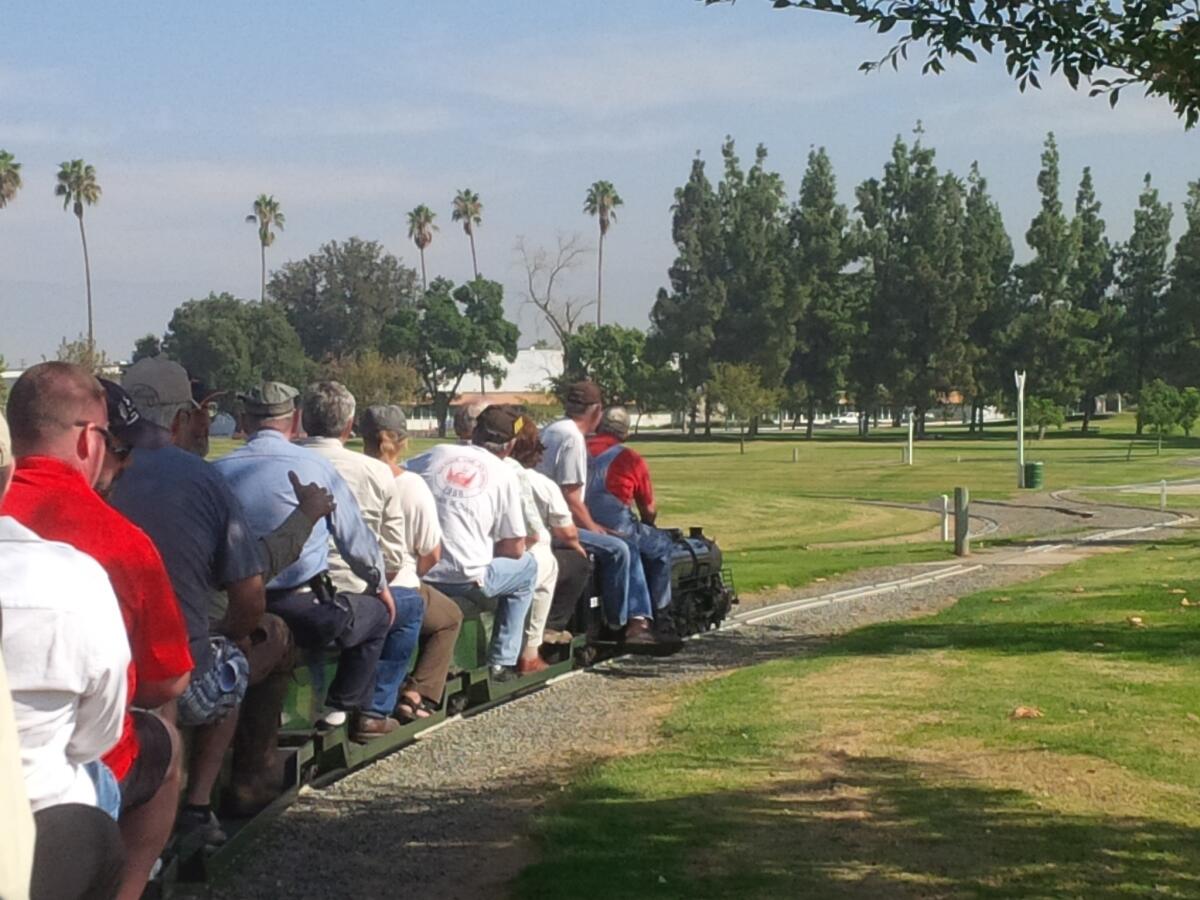Can trains, baseballs and slides coexist? Fairview Park panel chugs inland to see

- Share via
RIVERSIDE — Here in Hunter Hobby Park, balls, bats, playground slides and steaming locomotives share common ground.
The different users coexist and, apparently, get along in a space that works for everyone.
For some, this is the vision for Costa Mesa’s Fairview Park, whose roughly 45-acre southeast quadrant is primarily occupied by the Orange County Model Engineers and the group’s ridable trains.
But others have far different goals for Fairview Park: Leave the trains but otherwise keep the park natural, devoid of further development.
On Sunday morning, six members of the park’s citizens advisory committee, accompanied by a few city officials, trekked east to see how users of trains, playgrounds and sports fields recreate in close proximity. Members Lee Ramos, Dennis Popp and Frank Davern were absent.
The tour comes after the committee, which is gathering more information, delayed a vote in August on whether to recommend adding sports facilities to the southeast quadrant.
Since 1966, the Riverside Live Steamers — purportedly the only train club left in America that uses only steam locomotives — has used Hunter Hobby Park, a 32-acre city-owned park northeast of downtown Riverside.
For the past few years, the park also has contained two baseball/softball fields, two basketball courts, a multiuse field and playground equipment.
Riverside Councilman and Live Steamers member Mike Gardner told committee members, as the steam engine hissed behind him, that the park has gone through several master plans.
Its most recent, achieved through consensus-building from all interested parties, transformed the park into the multiuse facility it is today, he said.
“This is sweet,” said Fairview Park Citizens Advisory Committee member Steve Smith. “They did it right. Everybody brought their wants and needs to the table.”
Unlike Fairview Park’s southeast quadrant, however, Hunter Hobby Park is mostly flat. It’s located in a neighborhood dominated by business parks.
The Riverside train setup has similarities to its Orange County counterpart. Both are nonprofits in city-owned parks, and they have on-site service bays and operate on weekends. The trains are the same gauge — 7.5 inches — and they are enjoyed by thousands of riders each year.
The two clubs also share similar problems, occasional vandalism, particularly aluminum thefts, said Live Steamers President Dave Bunts.
When it comes to sharing the park with the trains, the sports community is polite and gracious, Bunts said.
On Sunday, as the committee rode around the park on a steam train, other park users played basketball, frolicked on the playgrounds or prepped for a baseball game.
Not all of Riverside’s tracks are gated, and park users are generally respectful when waiting for the trains, with or without a crossing guard’s help, Bunts said.
Some Fairview Park committee members said Costa Mesa’s 208-acre park, unlike Riverside’s, contains hilly expanses that would need significant grading to accommodate sports facilities. The Costa Mesa park also contains vernal pools — which are home to the San Diego fairy shrimp, an endangered species — and Native American archaeological sites.
Fairview Park committee Chairman Richard Mehren complimented the train ride, saying it was “probably worth a thousand words,” but said “enormous changes” would be required for sports facilities to be built in Fairview.
“I think it’s a big task,” Mehren said, “and a very expensive proposal.”
Member Ron Amburgey was more optimistic.
“I think we could have this in our city,” Amburgey said. “I don’t know why not. It’s beautiful.”
While riding the train, committee member Anna Vrska said she was noting in her mind the differences between Hunter Hobby Park and Fairview.
“It’s a lot different than having a nature preserve,” she said after the ride. “This is very manicured and controlled. It’s very nice, but that’s what was going through my mind as we were riding along.”
